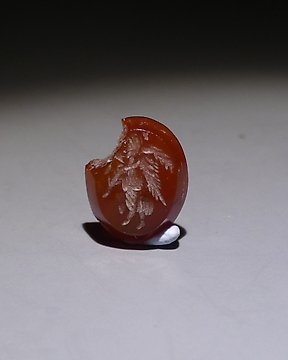
Romersk antikk Carne Entail med gud Eros. 11 mm H. 1. - 2. århundre e.Kr
Nr. 84324281

Nr. 84324281

Phallic Amulet with Wings.
Ancient Roman, 1st - 2nd century AD.
MATERIAL: Bronze.
DIMENSIONS: 7.5 cm length.
PROVENANCE: Private collection, Great Britain. Acquired in the 1960s.
CONDITION: Good condition. Intact.
DESCRIPTION:
A triple phallic amulet representing a winged and erect male member, with two zoomorphic feet. At the same time, another smaller phallus can be seen between the lower limbs, and one more on a larger scale toward at the back of the first.
Sometimes named the “phallic bird” or “zoomorphic” phallus, the winged male sexual attribute was an habitual motif in Roman iconography, as it incorporated velocity, power, and rapidity. Numerous amulets of this type have been found throughout the Imperial realm, and helping to fill public and private collections.
This is a motif inherited from the Greek repertoire, as it symbolises the god Priapus, a minor divinity seen always with a permanent erection, an artistic resort with which to allude to the fecundity of nature, to abundance and harvests. At the same time, Priapus also had a role warding off the evil eye and protecting homes from thieves. This is the reason why the erect phallus appears on numerous amulets, oil lamps, statuettes and tintinnabula. The latter, generally made of bronze, were made up of a winged phallus from which wind chimes hung, and they were placed in gardens and porticos with the aim of protecting the property and bringing good fortune to the inmates. Various examples have been recovered from Pompeii, which testifies to the popularity of this fetish among the distinct social classes.
BIBLIOGRAPHY:
- Los bronces romanos en España. 1990. p. 251, figs. 167-169.
- GRANT. Eros in Pompeii, The Erotic Collection of the Museum of Naples. 1997. p. 139.
- JOHNS. Sex or Symbol? Erotic Images of Greece and Rome. 1990. n. 52.
PARALLELS:
Fig. 1. Tintinnabulum, bronze, from Pompeii, Museo Archeologico Nazionale di Napoli, inv. 27835.
Fig. 2. Christie’s, Sale 9050 New York, Ars Amatoria: The Haddad Family Collection of Erotic art, 17/12/1998, lot 68.
Fig. 3. Phallic tintinnabulum, bronze, length 10cm, British Museum n. 1865,1118.208.
Fig. 4. Phallic amulet, 2nd – 3rd century AD, length 5 cm, Museo Arqueológico y Etnológico de Córdoba, CE002885.
Fig. 5. Bronze amulet, 2nd - 3rd century AD, Kinský Palace, Praga, NM-H10 7087.
Notes:
- The piece includes authenticity certificate.
- The piece includes Spanish Export License (Passport for European Union) - If the piece is destined outside the European Union a substitution of the export permit should be requested, can take between 1-2 weeks maximum.
- The seller guarantees that he acquired this piece according to all national and international laws related to the ownership of cultural property. Provenance statement seen by Catawiki.
Hvordan kjøpe på Catawiki
1. Oppdag noe spesielt
2. Legg inn det høyeste budet
3. Å gjøre en sikker betaling